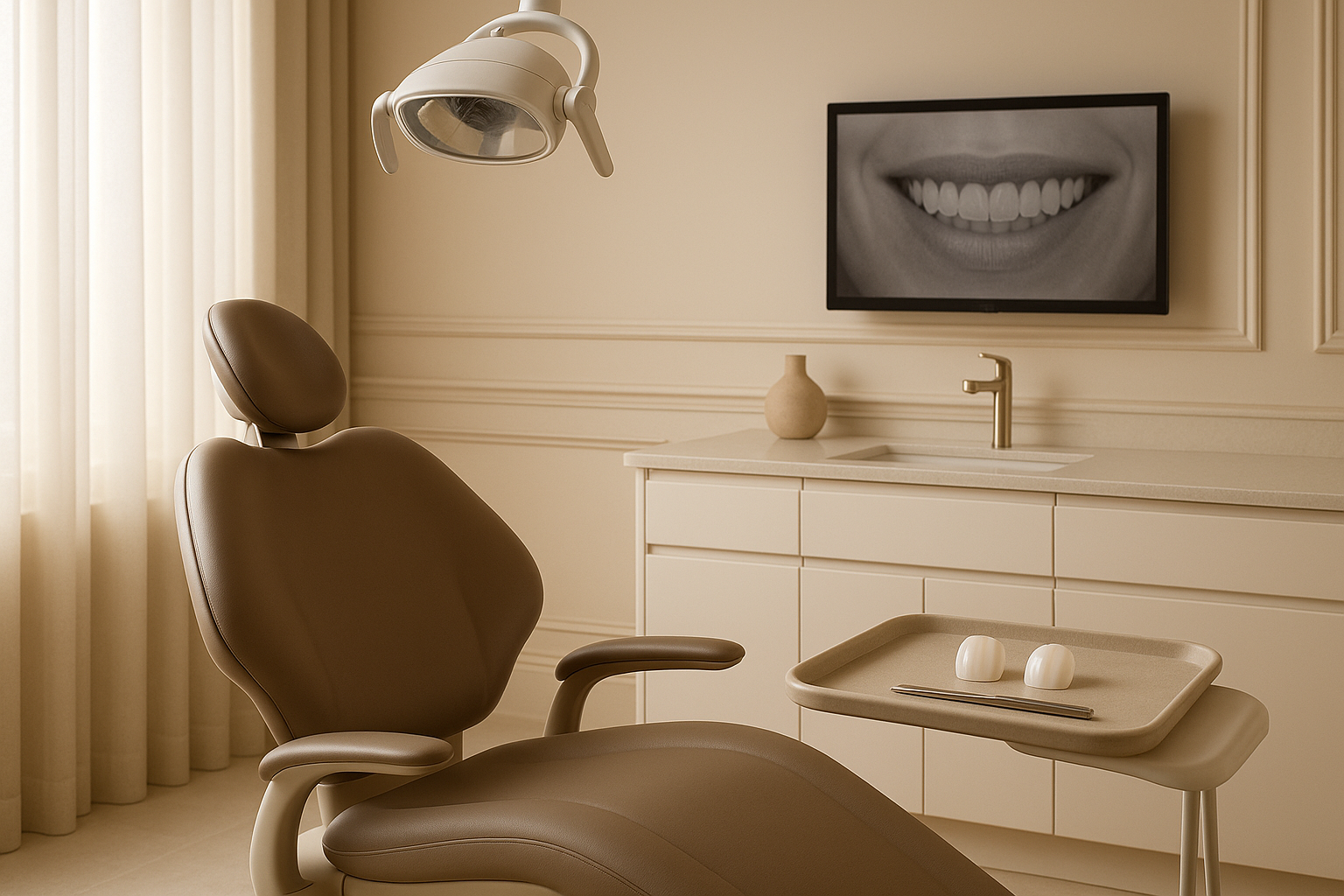No-Prep Veneers vs Traditional Veneers: 9 Trade-offs Dentists Want You To Understand

A confident smile changes how you feel in a room and how others respond to you. Veneers often sit at the centre of that transformation because they refine colour, shape and symmetry without resorting to full crowns. The most common decision people face is whether to choose no-prep veneers or traditional veneers. Both can produce natural results and both can be long lasting, yet they solve slightly different problems and carry different consequences for your enamel and your bite.
This guide explains the science behind each approach in clear language. You will learn what enamel preservation really means, how veneer thickness influences the final look, when no-prep works beautifully and when traditional preparation provides better control, how sensitivity is avoided, and how to care for your new smile so that it lasts. The treatment pathway described mirrors an imaging-led workflow used at SwissMed Clinic, where OPG and CBCT are available on site alongside digital scanning and photography. That technology is mentioned only where it affects decision making, because veneers succeed through careful planning rather than brand repetition.
How veneers work
A veneer is a thin shell bonded to the front surface of a tooth in order to adjust colour, length and contour. The shell is usually made from porcelain or composite resin. Once bonded, it becomes part of the outer surface and shares the load during chewing. The most reliable bond is created when the adhesive locks into etched enamel rather than exposed dentine, which is why conservative planning matters. Veneers are not crowns. A crown surrounds the whole tooth above the gum and is reserved for heavily filled or cracked teeth. A veneer preserves more tooth structure because it focuses on the visible surface.
Two principles drive predictable veneer dentistry. The first is to keep as much work as possible within enamel for strong bonding and reduced sensitivity. The second is to balance the bite so that no single edge is overloaded when you speak, chew or clench. If those two principles guide case selection and design, both no-prep and traditional veneers can serve well for many years.
What no-prep veneers really mean
No-prep veneers are designed to be bonded to the existing enamel with little or no mechanical reduction. The tooth surface is still thoroughly cleaned, micro-roughened and etched so that the adhesive can penetrate, but the intention is to add material rather than cut it away. This approach suits teeth that are slightly retruded, a little small or mildly spaced, because the added thickness helps reach an ideal contour without making the teeth look bulky. It is less suitable where teeth are already prominent, rotated or heavily discoloured, because adding material without removing any may leave the final shape fuller than intended or allow underlying colour to show through.
Ultra-thin porcelain is often used for no-prep veneers. These contact-lens-like shells can look wonderfully natural on a favourable background. Composite resin can also be used either freehand in one visit or as a lab-made veneer bonded later. The more conservative the preparation, the more the final result depends on precise smile design and the skill of the dentist and technician.
What traditional veneers involve
Traditional veneers typically include planned enamel reduction guided by a wax-up or digital mock-up. The aim is to create a small amount of extra space so that the final veneer can deliver refined contours without feeling thick at the edges. The depth of reduction is measured in tenths of a millimetre and is kept within enamel wherever possible to maintain bond strength. This additional space supports better control of alignment, shape and translucency. It also allows the technician to layer ceramics to mask deeper staining more predictably. The trade-off is permanence. Once enamel is reduced, the tooth will always require some form of restorative covering.
Trade-off 1: Enamel preservation versus contour control
No-prep veneers preserve enamel, which is your natural armour against sensitivity and wear. They bond to the strongest substrate and avoid unnecessary removal of tooth structure. The sacrifice is control of contour. If a tooth is slightly forward or rotated, simply adding material can make it look fuller. Traditional veneers remove a measured amount of enamel so the technician can reposition edges and create slimmer, more sculpted profiles that harmonise with your lips and facial features.
Trade-off 2: Candidacy and flexibility
No-prep suits small teeth, flat facial surfaces and mild spacing or wear. It is best where the colour change needed is moderate rather than dramatic. Traditional veneers handle a wider range of starting points. If you want to correct mild crowding without orthodontics, mask deep discolouration, or reshape prominent teeth to reduce fullness, traditional preparation provides the design freedom to achieve a natural result while maintaining strength.
Trade-off 3: Reversibility and long-term commitments
No veneer is truly reversible because bonding alters the enamel surface and the tooth adapts to a new shape. No-prep is closer to reversible in the sense that less enamel is changed, but it should still be considered a long-term restoration. Traditional veneers represent a permanent commitment because enamel has been removed to create space. That commitment is not a drawback when the design is conservative and the bite is balanced, but it must be understood before you begin, particularly if you are young.
Trade-off 4: Aesthetics, translucency and masking power
Ultra-thin porcelain can deliver beautiful translucency that mimics natural enamel. On bright, even teeth this can look indistinguishable from untouched tooth structure. The weakness is masking. If the underlying tooth has deep staining or large, dark fillings, a very thin veneer can allow those tones to influence the final colour. Traditional veneers are thicker and can be layered to block and diffuse unwanted shades while still appearing lifelike. They are more reliable when the colour shift needed is substantial.
Trade-off 5: Durability and chipping risk
Both approaches can be durable when the case is planned around your bite. Thin margins are more sensitive to overload if the opposing teeth hit them squarely or if a lot of length has been added to worn edges. Traditional veneers allow the use of stronger ceramics in high-stress zones and give the dentist more scope to fine-tune the way the teeth meet. If you clench or grind, you will likely be advised to wear a protective night guard regardless of veneer type.
Trade-off 6: Gum health and cleanability
Healthy gums depend on smooth transitions at the veneer margin and daily plaque control. No-prep veneers bond to the existing contour, which may leave a slightly fuller profile if significant shape change is needed. That is not a problem when margins are polished perfectly and home care is consistent, but it can make technique more important. Traditional preparation lets the dentist position the margin deliberately and shape the emergence into the gum line with precision. Either method is compatible with healthy tissues when the finish is meticulous and the patient cleans well.
Trade-off 7: Sensitivity and comfort
Working within enamel keeps sensitivity low for both approaches. No-prep tends to be comfortable because the enamel surface is largely preserved. Traditional veneers can cause temporary sensitivity in areas where more enamel is removed, although careful planning keeps this to a minimum. Once bonded, most people find both types feel natural. Pre-existing gum recession, wear or cracks are discussed in advance so that the bonding protocol protects vulnerable areas.
Trade-off 8: Time to result and visit flow
No-prep and traditional cases share a similar early pathway. Records are taken, photos and scans are made, and a smile design is created. A trial smile is placed so that you can judge shape and length in real life. For no-prep, the final veneers are often bonded without a provisional phase. For traditional veneers, you usually wear provisional veneers while the lab fabricates the final set. That extra step lets you test speech, lip support and edge positions and give feedback before anything is finalised.
Trade-off 9: Cost and long-term value
Costs vary with the number of teeth, the material, the complexity of the bite and the level of lab artistry. No-prep can be cost-effective for straightforward cases where the plan involves subtle refinements. Traditional veneers generally involve more planning and a laboratory phase, which raises the fee, but they also deliver a wider range of corrections. The best value lies in a result that integrates with your bite and requires fewer unplanned adjustments over the years.
Materials and why they matter
Porcelain veneers are commonly fabricated from lithium disilicate or feldspathic porcelain. Lithium disilicate provides strength with natural translucency and is well suited to cases that need reinforcement in specific areas. Feldspathic porcelain is hand layered and can be feathered to ultra-thin edges, which makes it a strong candidate for conservative no-prep work on favourable teeth. Composite resin veneers come as direct chairside applications or as indirect lab-made shells. Composite is easier to repair and conservative in a single visit, although it can pick up surface staining more quickly and may need periodic polishing or refurbishment.
Material selection is personalised. Stronger ceramics help resist chipping under normal function. More translucent ceramics create depth but transmit the colour beneath. The final choice balances tooth shade, desired brightness, the amount of alignment change and your bite dynamics.
Eligibility and case selection
Good veneer dentistry starts with honest case selection. If your teeth are slightly retruded, modestly spaced or a little short from wear, no-prep veneers can achieve a refined, natural look without removing enamel. If you have deep staining, prominent edges, large mismatched fillings or mild crowding that you do not wish to correct orthodontically, traditional veneers generally provide better control and predictability. If your bite shows heavy edge-to-edge contact or you grind at night, the treatment plan will include occlusal adjustments and a protective appliance to keep the new edges safe.
Step by step: an imaging-led pathway
Treatment begins with a consultation that includes photographs, a digital scan and, where indicated, panoramic OPG imaging. CBCT is considered when root angulation, enamel thickness or joint position needs to be assessed in three dimensions. These images inform safe reduction depths and guide decisions about where space exists and where it must be created. A digital smile design or wax-up is produced to visualise the proposed shape.
A reversible trial smile is then placed over your existing teeth. This mock-up allows you to see the proposed length and contour in natural light and to test speech and lip support. Feedback is incorporated before any permanent step. For no-prep veneers, bonding usually follows after fine surface conditioning. The veneers are tried in with a clear gel so that colour can be assessed with the enamel background visible. Adhesive cement is then used to bond each veneer and margins are polished to a high gloss.
For traditional veneers, minimal enamel reduction is completed using depth guides based on the design. Digital or physical impressions are taken and provisional veneers are fitted. You live with these provisionals for a short period and note any adjustments you would like. The final ceramics are fabricated by the laboratory and bonded at a subsequent visit. Occlusion is then fine-tuned so that your teeth meet comfortably in all movements.
Risks and how they are mitigated
Every veneer carries a small risk of chipping, debonding or marginal staining. Those risks increase when the bite overloads a thin edge, when home care is inconsistent or when smoking is present. Gum recession can reveal a margin over time and may prompt a repair or replacement for the best appearance. These realities are not unique to either method. Ultra-thin margins are more sensitive to overload and deeper preparations can raise the chance of sensitivity if dentine is approached. Conservative design, imaging-guided planning and meticulous bonding protocols reduce these risks considerably. People who clench or grind receive a custom night guard to protect the investment.
Aftercare and everyday habits
Veneers last longer when they are treated like healthy natural teeth and protected from avoidable stress. Brushing twice daily with a fluoride toothpaste keeps margins clean. Interdental cleaning prevents plaque from accumulating at the edges. Non-abrasive polishing pastes preserve the glaze and maintain a high shine. Regular hygiene visits allow early correction of tiny chips or roughness before they propagate and they provide an opportunity to review your bite if anything changes. Avoid opening packets with your teeth or biting very hard items directly with veneered edges. If whitening is part of your plan, it is organised before veneers are designed so that the new colour can be matched accurately. Porcelain does not bleach, although surrounding natural teeth can be maintained with occasional whitening top-ups.
Costs and sensible budgeting
Fees are influenced by the number of teeth involved, the material, the need for provisional stages and the complexity of your bite. Additional procedures such as minor gum contouring or bite equilibration can improve the result and may be recommended where appropriate. It is wise to budget for a protective night guard if you clench or grind and for periodic maintenance such as polishing or repairs to composite edges over the years. Many people stage treatment by starting with the upper front teeth that dominate the smile and scheduling the lower teeth later.
A narrative comparison without a checklist
People often want a single answer to the question of which type is best. There is no universal winner. If your teeth are slightly small and set back and you want a measured brightness and refined shape, no-prep veneers are a conservative way to achieve that with minimal alteration. If you want to correct prominent edges, camouflage deep colour changes or sculpt a slimmer outline, traditional veneers provide the design space and material thickness to do it predictably. What matters is an honest discussion of objectives, a reversible trial smile and a willingness to adjust the design before anything permanent is bonded.
Frequently asked questions
Are no-prep veneers really reversible?
They are more conservative and they preserve the most enamel, but they are not truly reversible. The enamel surface is etched to accept the adhesive and the tooth adapts to a new shape. If removal becomes necessary in future, a skilled dentist can often restore the enamel surface with minimal additional work, yet some alteration will always remain.
Do no-prep veneers look bulky?
They can appear fuller if placed on prominent or crowded teeth because material is added without creating space. If the teeth are slightly retruded or undersized, the added thickness lands at a natural final position and looks slim. A trial smile placed over your teeth is the best way to preview how the contour will look in your own mouth.
Which lasts longer?
Longevity is similar when cases are selected well and the bite is balanced. Traditional veneers are more versatile in complex situations and allow the use of stronger ceramics in stress areas, which can support durability where substantial shape change is planned. Night guards for clenching and regular maintenance visits improve lifespan for both types.
Can veneers stain?
Porcelain is highly stain resistant. Composite resin can pick up surface staining more readily and benefits from occasional polishing. Any veneer can show margin staining if plaque accumulates. Daily cleaning and professional maintenance keep edges fresh and gums healthy.
Will I need a root canal after veneers?
The risk is low, especially when preparations stay within enamel and bonding protocols are managed carefully. Existing cracks, very deep fillings or aggressive reduction increase the risk, which is why conservative planning is important and why imaging is used to map enamel thickness before cutting.
Can veneers fix crooked teeth without braces?
Mild misalignment can be disguised by adjusting contours and edge positions. Significant crowding is better treated with orthodontics first. Traditional veneers offer more scope to refine apparent alignment because they create space for repositioning, but there are limits to what is sensible without moving teeth.
How many veneers do I need for a natural look?
Some people achieve a pleasing change with two or four veneers around the front. Others benefit from six or eight so that colour and shape are controlled across the smile zone. A digital simulation shows how many are needed to achieve your aims without over-treating.
Do veneers damage natural teeth?
When designed conservatively, veneers can protect worn enamel and reinforce chipped edges. Damage tends to occur when teeth are over-prepared, when veneers are used to mask problems that should be addressed orthodontically, or when the bite is not balanced. The safest plans are the ones that respect anatomy and function first.
Book an At Home GP Visit
If you would like to see how veneers could look on your own teeth, book a consultation with SwissMed Clinic. You will receive a digital smile design, a reversible trial smile and a personalized plan that explains whether no-prep or traditional veneers will meet your goals. You will also receive a clear outline of costs and timelines so you can make an informed decision with confidence.







